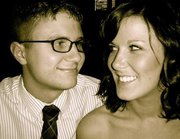Epub – What the Media Isn’t Telling You (Part 2)
When the media mentions self-publishing, it’s often to highlight the rare, few authors whose e-books sell by the tens of thousands. But headlines don’t tend to say much about the average person’s experience. That’s why today, and for the next few weeks, I’ll be asking five self-published author exactly what it’s like to self-publish and sell a book.
I asked each author the same three introductory questions for today’s post. You can read their answers below their website and book info. Check back next Monday to hear more about how each of them designed and went about marketing their book, as well as the results.
Amy Bennett
Her book: Entangled
Websites: www.EntangledBook.com and www.PermissionToPeruse.
Sarah: Did you consider traditional publishing? What made you go the self-publishing route?
Amy: No. A few reasons played into that. I knew I wouldn’t have the word count required for traditional publishing. Queries, proposals and all the marketing, to be honest, is also a little scary. I liked the idea that I didn’t have to deal with rejections and I was in charge of the entire process. And more importantly, I was in charge of the timeline. I had a message to get out and I wanted it to happen right away. In addition, I already have a full time job with two young girls and I just didn’t feel like I had the time or effort required for traditional publishing.
Sarah: What service/company did you use to self-publish your book?
Amy: I heavily used Melissa Oyler Designs (MOD) in conjunction with CreateSpace.com to publish the paperback version.
Sarah: Are you willing to share how much it cost to use this service?
His book: Every Bush Is Burning
Website: www.EveryBush.com and www.BrandonClements.com
Sarah: Did you consider traditional publishing? What made you go the self-publishing route?
Brandon: Absolutely. The editor I worked with felt good about my chances getting in with a Christian publisher, but that’s where it got complicated. My book is a story about a rough around the edges guy named Jack, and it’s intended to start conversations with people who have been turned away from Jesus because of sins of the church. So I felt strongly that in order for the character and story to ring true, there needed to be a little true-to-life rawness in the story, some PG-13 grit and messiness. I learned that if I wanted to go with a Christian publisher, I would have to change some things about the story that I just didn’t want to change. I debated it for sure, because as well all know it’s easier to have some help. In the end I decided to leave the book as it was and figure out how to publish it myself, because I thought it was worth it.
So that kind of made my decision for me, and I didn’t pursue an agent or publisher. I’m not against traditional publishers, however, and would definitely be open to writing for one in the future.
Lastly, another big reason that I loved the idea of self-publishing was that I could make prices as low as possible to reduce barriers that might keep people from getting it.
Sarah: What service/company did you use to self-publish your book?
Brandon: I technically formed my own publishing company (Twisted Beam Press) and used a company called Lightning Source to print it (they distribute print on demand titles directly to online retailers through Ingram).I chose them because they have the best quality of printing, hands down. My paperback has an incredible matte cover and looks as good as any traditionally published book. I had some test versions printed with other companies and when you put them side by side the difference is astounding (in large part due to the gloss laminate covers that other printers use). They also pay the best author royalties of any company I found, so that was a plus.The main con of going through them (and it’s a large one) is that it takes a hefty amount of work to work with them. They treat you like a publisher and they are very upfront about the fact that they are not a self-publishing services company. From starting an account to paperwork to learning their file types—it is not easy and it’s not very user friendly. They have a ton of helpful info on their website, but it’s very spread out and hard to find. I read an entire book to learn how to work with them (it’s called POD For Profit—the cover looks terrible but it was incredibly helpful).It was a lot of work, but the end result was more than worth it and I couldn’t be happier.
Sarah: Are you willing to share how much it cost to use this service?
Brandon: Sure. Working with them cuts out all of the middlemen, so it’s very cheap. It costs nothing to have an account with them, and uploading a book costs $100 (and that includes a proof copy overnighted to you). Aside from that, I had to buy ISBN’s which cost $250 for a block of ten.
Of course, that doesn’t include other costs I invested (like editing), but that was all it took to use Lightning Source.
Mike Hall
His book: Jigsaw
Website: www.JigsawBook.com and facebook.com/mikeisspeaking
Sarah: Did you consider traditional publishing? What made you go the self-publishing route?
Mike: Having grown up around bands and going to shows, I had seen the process of self-promotion and self-publishing music. Then, when things pick up, you get label interest. This was basically the only route I was familiar with, so I ventured in this direction. I did the design, and writing. My wife did the editing (she’s a high school English teacher). Paid someone to do the page layout. A good friend created 35 original illustrations. Another friend (who is a middle school guidance counselor) wrote a page or two for each chapter from her perspective.
Sarah: What service/company did you use to self-publish your book?
Mike: A&A Publishing in Tampa. By far, it was a great experience working with them. Very affordable company and they have no minimum print run. No minuses to speak of!! They even threw in 50 free copies on top of the 500 that I ordered. Super nice peeps!
Sarah: Are you willing to share how much it cost to use this service?
Mike: Total cost out of pocket for me was $1700, including 150 for the layout work that was done elsewhere.
Andy Merritt
His book: Eden
Website: www.EdenTheBook.com and www.recklessliving.com
Sarah: Did you consider traditional publishing? What made you go the self-publishing route?
Andy: I considered it but the difficulty in getting a traditional publisher or agent to even look at a manuscript or book proposal kept me from pursuing it very far.
Sarah: What service/company did you use to self-publish your book?
Andy: I went through Create Space. There are some serious plusses with them, but also a few minuses. On the plus side they are owned by Amazon, so inclusion in Amazon’s store is seamless. Your book also always shows up as “In Stock” at Amazon, which is important to buyers. There is very little overhead and the price for the author to purchase each copy is about the lowest I could find.
On the minus side commissions paid on books sold through the Amazon store are relatively low. They also do not offer hard cover printing options.
Sarah: Are you willing to share how much it cost to use this service?
Andy: As long as you do the design work yourself (or have it done by someone else) the costs are mimimal. You need to purchase a physical proof before you can approve the book to be sold. They also have a “Pro” plan you can purchase for $39 that dramatically decreases your costs per copy. As long as you sell 50 copies or more it is money you easily make back and saves you in the long run.
I had other overhead costs getting started: cover images, I printed preview copies for review, web hosting, etc. Probably around $400 to get started.
Jimmy Spencer
His book: Love Without an Agenda
Website: www.book.lovewithoutagenda.com
Sarah: Did you consider traditional publishing? What made you go the self-publishing route?
Jimmy: I wrote the book with my charity’s (also called Love Without Agenda) CoFounder Lisa O’Brien-Wentzel who contributed a ton of ideas and content editing within the process. Once we had a working manuscript, we did investigate tradition publishing as a viable model. We decided that for people who were not famous (or who didn’t have a large following), traditional publishing wasn’t very practical or beneficial.
We decided to self-publish because we had a really unique situation. Publishers essentially do three things for you. They design the actual book, they print the book, and they market the book. As the founder of a charity, I knew I had resources such as a co-writer, a professional designer, an in-house editor, and website and e-book people. We had a great creative team that could produce a book (and related materials) that we were confident would stand up to any major publishing house. The only piece we are ‘iffy’ on is the actual marketing….but we are sure we’ll figure that out too! Not surprisingly, we’ve found in our interviews with many national authors that their publishers offered very little in marketing (unless they were already a iconic figure).
We realized that we had all the pieces to create, print, and market a book. So we just went for it.
Sarah: What service/company did you use to self-publish your book?
Jimmy: A donor provided the funds for the first edition of 3000 books. We printed them with a local printer John S Swift. They let us come out on the day of printing and document the process and even gave us the metal book plates that the books were created on. We use those plates to say ‘thank you’ to major Love Without Agenda donors.
Sarah: Are you willing to share how much it cost to use this service?
Jimmy:It cost us $12,700 to print the actual books plus miscellaneous costs such as shipping & storage that brought the final total to around $15,000.
(It’s fair to note here that Jimmy printed a big first run of books, which is why his costs were higher than others mentioned.)
**If you find this series helpful or if you or someone you know has self-publishing or e-publishing experience to share, please leave me a comment. Also, if you’re setting out to write your book, I’ve started a free community to support aspiring authors.**







Stephen Haggerty February 6, 2012 (11:47 am)
Awesome advice. I’ve enjoyed reading Brandon’s blog, and this has been helpful to read about his and others’ publishing process. Thanks!
Joanna February 7, 2012 (1:37 am)
Thanks Sarah. Good to get some honest opinions about the publishing options available.
BLOG Interview | Reckless Living February 8, 2012 (8:52 am)
[…] sarahcunningham.org Andy Tagged: […]
Brad February 13, 2012 (9:24 am)
http://Www.lifechangecommunity.org
Sarah February 13, 2012 (9:57 am)
Thanks for the visit @brad!